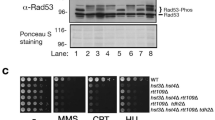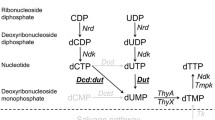Abstract
We reported previously that the product of DIN7, a DNA damage-inducible gene of Saccharomyces cerevisiae, belongs to the XPG family of proteins, which are involved in DNA repair and replication. This family includes the S. cerevisiae protein Rad2p and its human homolog XPGC, Rad27p and its mammalian homolog FEN-1, and Exonuclease I (Exo I). Interestingly, Din7p is the only member of the XPG family which specifically functions in mitochondria. We reported previously that overexpression of DIN7 results in a mitochondrial mutator phenotype. In the present study we wished to test the hypothesis that this phenotype is dependent on the nuclease activity of Din7p. For this purpose, we constructed two alleles, din7-D78A and din7-D173A, which encode proteins in which highly conserved aspartates important for the nuclease activity of the XPG proteins have been replaced by alanines. Here, we report that overexpression of the mutant alleles, in contrast to DIN7, fails to increase the frequency of mitochondrial petite mutants or erythromycin-resistant (Er) mutants. Also, overproduction of din7-D78Ap does not result in destabilization of poly GT tracts in mitochondrial DNA (mtDNA), the phenotype observed in cells that overexpress Din7p. We also show that petite mutants induced by enhanced synthesis of wild-type Din7p exhibit gross rearrangements of mtDNA, and that this correlates with enhanced recombination within the mitochondrial cyt b gene. These results suggest that the stability of the mitochondrial genome of S. cerevisiae is modulated by the level of the nuclease Din7p.




Similar content being viewed by others
References
Amin NS, Nguyen M, Oh S, Kolodner RD (2001) exo1 -dependent mutator mutations: model system for studying functional interactions in mismatch repair. Mol Cell Biol 21:5142–5155
Bernardi G (1979) The petites mutation in yeast. Trends Biochem Sci 4:197–201
Boiteux S, Gellon L, Guibourt N (2002) Repair of 8-oxoguanine in Saccharomyces cerevisiae: interplay of DNA repair and replication mechanisms. Free Radical Biol Med 32:1244–1253
Chen XJ, Guan MX, Clark-Walker GD (1993) MGM101, a nuclear gene involved in maintenance of the mitochondrial genome in Saccharomyces cerevisiae. Nucleic Acids Res 21:3473–3477
Cui Z, Mason T (1989) A single nucleotide substitution at the rib2 locus of the yeast mitochondrial gene for 21S rRNA confers resistance to erythromycin and cold-sensitive ribosome assembly. Curr Genet 16:273–279
Chi NW, Kolodner RD (1994) Purification and characterization of MSH1, a yeast mitochondrial protein that binds to DNA mismatches. J Biol Chem 269:29984–29992
Davies AM, Hershman S, Stabley GJ, Hoek JB, Peterson J, Cahill A (2003) A Ca2+-induced mitochondrial permeability transition causes complete release of rat liver endonuclease G activity from its exclusive location within the mitochondrial intermembrane space. Identification of a novel endo-exonuclease activity residing within the mitochondrial matrix. Nucleic Acids Res 31:1364–1373
Dujon B (1981) Mitochondrial genetics and functions. In: Strathern JN, Jones FW, Broach JR (eds) The molecular biology of yeast Saccharomyces. Cold Spring Harbor Laboratory Press, Cold Spring Harbor, N.Y., pp 505–635
Fikus MU, Mieczkowski PA, Koprowski P, Sledziewska-Gojska E, Ciesla Z (2000) The product of the DNA damage-inducible gene of Saccharomyces cerevisiae, DIN7 , specifically functions in mitochondria. Genetics 154:73–81
Fishel R (1998) Mismatch repair, molecular switches and signal transduction. Genes Dev. 12:2096–2101
Foury F (1989) Cloning and sequencing of the nuclear gene MIP1 encoding the catalytic subunit of the yeast mitochondrial DNA polymerase. J Biol Chem 264; 20552–20560
Fox TD, Folley IS, Mulero JJ, McMullin TW, Thornsess PE, Hedin LO, Costanzo MC (1991) Analysis and manipulations of yeast mitochondrial genes. Methods Enzymol 194:149–165
Gash AP, Huang M, Metzer S, Botstein D, Elledge SJ, Brown PO (2001) Genomic expression response to DNA damaging agents and the regulatory role of the yeast ATR homolog Mec1p. Mol Biol Cell 12:2987–3003
Hsieh P (2001) Molecular mechanism of DNA mismatch repair. Mutation Res 486:71–87
Hwang KY, Baek K, Kim HY, Cho Y (1998) The crystal structure of flap endonuclease-1 from Methanococcus jannaschii. Nat Struct Biol 5:707–713
Kang D, Hamasaki N (2002) Maintenance of mitochondrial DNA integrity: repair and degradation. Curr Genet 41:311–322
Koprowski P, Fikus MU, Mieczkowski P, Ciesla Z (2002) A dominant mitochondrial mutator phenotype of Saccharomyces cerevisiae conferred by msh1 alleles altered in the sequence encoding the ATP-binding domain. Mol Genet Genomics 266:988–994
Lazowska J, Jacq C, Slonimski PP (1980) Sequence of introns and flanking exons in wild-type and box3 mutants reveals an interlaced splicing protein coded by an intron. Cell 22:333–348
Lazowska J, Claisse M, Gargouri A, Kotylak Z, Spyridakis A, Slonimski PP (1989) Protein encoded by the third intron of cytochrome b gene in Saccharomyces cerevisiae is an mRNA maturase. Analysis of mitochondrial mutants, RNA transcripts, proteins and evulotionary relationships. J Mol Biol 205:275–289
Lee BI, Nguyen LH, Barsky D, Fernandes M, Wilson DM (2002) Molecular interactions of human Exo I with DNA. Nucleic Acids Res 30:942–949
Lewis LK, Karthikeyan G, Westmoreland JW, Resnick MA (2002) Differential suppression of DNA repair deficiencies of yeast rad50, mre11, and xrs2 mutants by EXO1 and TLC1 (the RNA component of telomerase). Genetics 160:49–62
Marsischky GT, Lee S, Griffith J, Kolodner RD (1999) Saccharomyces cerevisiae MSH2/6 complex interacts with Holliday junctions and facilitates their cleavage by phage resolution enzymes. J Biol Chem 274:7200–7206
Mieczkowski P, Fikus M, Ciesla Z (1997) Characterization of a novel DNA damage-inducible gene of Saccharomyces cerevisiae, which is a structural homolog of the RAD2 and RAD27 DNA repair genes. Mol Gen Genet 253:655–665
Reenan RA, Kolodner RD (1992) Isolation and characterization of the Saccharomyces cerevisiae genes encoding homologs of HexA and MutS mismatch repair proteins. Genetics 132:963–973
Sia EA, Butler CA, Dominska M, Greenwell P, Fox TD, Petes TD (2000) Analysis of microsatellite mutations in the mitochondrial DNA of Saccharomyces cerevisiae. Proc Natl Acad Sci USA 97:250–255
Singh KK, Sigala B, Sikder HA, Schwimmer C (2001) Inactivation of Saccharomyces cerevisiae OGG1 DNA repair gene leads to an increased frequency of mitochondrial mutants. Nucleic Acids Res 29:1381–1388
Sugawara N, Paques F, Colaicova M, Haber JE (1997) Role of Saccharomyces cerevisiae Msh2 and Msh3 repair proteins in double-strand break-induced recombination. Proc Natl Acad Sci USA 94:9214–9219
Szostak JW, Orr-Weaver TL, Rothstein RJ, Stahl FW (1983) The double-strand-break repair model for recombination. Cell 33:25–35
Tishkoff DX, Boerger AL, Bertrand P, Filosi N, Gaida GM, Kane MF, Kolodner RD (1977) Identification and characterization of Saccharomyces cerevisiae EXO I, a gene coding for an exonuclease that interacts with MSH2. Proc Natl Acad Sci USA 94:7487–7492
Van Dyck E, Foury F, Stillman B, Brill SJ (1992) A single stranded DNA binding protein required for mitochondrial DNA replication in S. cerevisiae is homologous to E. coli SSB. EMBO J 11:3421–3430
Vanderstraeten S, Van der Brule S, Hu J, Foury F (1998) The role of 3′-5′ exonucleolytic proofreading and mismatch repair in yeast mitochondrial DNA error avoidance. J Biol Chem 273:23690–23697
Willer M, Rainey M, Pullen T, Stirling CJ (1999) The yeast CDC9 gene encodes both a nuclear and a mitochondrial form of DNA ligase. Curr Biol 9:1085–1094
Zelenaya-Troitskaya O, Newman SM, Okamoto K, Perlman PS, Butow RA (1998) Functions of the high mobility group protein, Abf2p, in mitochondrial DNA segregation, recombination and copy number in Saccharomyces cerevisiae. Genetics 148:1763–1766
Acknowledgements
We thank Prof. P. Slonimski for encouraging us to perform recombination experiments. We are grateful to Dr. Thomas D. Petes for providing the S. cerevisiae strains CAB152, CAB162 and CAB 193. This work was supported by Grant No. 3 P04A 029 23 from the Polish State Commitee for Scientific Research (KBN)
Author information
Authors and Affiliations
Corresponding author
Additional information
Communicated by R. Devoret
Rights and permissions
About this article
Cite this article
Koprowski, P., Fikus, M.U., Dzierzbicki, P. et al. Enhanced expression of the DNA damage-inducible gene DIN7 results in increased mutagenesis of mitochondrial DNA in Saccharomyces cerevisiae . Mol Gen Genomics 269, 632–639 (2003). https://doi.org/10.1007/s00438-003-0873-8
Received:
Accepted:
Published:
Issue Date:
DOI: https://doi.org/10.1007/s00438-003-0873-8




